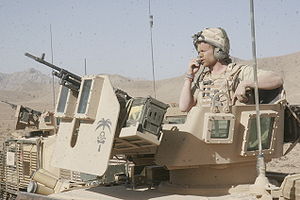Operation Eagle's Summit
| Operation Eagle's Summit | |||||||
|---|---|---|---|---|---|---|---|
| Part of the War in Afghanistan (2001–present) | |||||||
 British troops of the Queen's Royal Lancers providing security for the convoy. |
|||||||
|
|||||||
| Belligerents | |||||||
|
Coalition: |
|
||||||
| Commanders and leaders | |||||||
|
|
? | ||||||
| Strength | |||||||
| UK: 2,000 Other ISAF: 1,000 ANA: 1,000 Total: 5,000 |
Unknown | ||||||
| Casualties and losses | |||||||
| Canada: 1 killed, 7 injured UK: 2 injured ANA: 2 injured |
200 killed (NATO claim) | ||||||
Operation Eagle's Summit (Oqab Tsuka in Pashto) was a military operation conducted by ISAF and Afghan National Army troops, with the objective of transporting a 220-tonne turbine to the Kajaki Dam in Helmand Province through territory controlled by Taliban insurgents. Ending in success for the coalition, it involved mostly British troops, and was said to have been one of the largest logistical operations carried out by the British Army since World War II. The operation took its name from the eagle pictured on the insignia of the 16th Air Assault Brigade.
The Kajaki hydroelectric dam was completed in 1953 with the aid of a loan from the Export-Import Bank of the United States, in order to provide electricity and irrigation to the population of Helmand and Kandahar provinces under the Helmand Valley Authority. It was supposed to house three turbines, but only two were ever installed, and after years of civil war, only one was still in service by 2001 In 2004, the United States started work on restoring the dam's capacity and bringing its output to 53 megawatts. One turbine was repaired in 2005, but the restoration was hampered by the difficulty of delivering new turbines to Kajaki through Taliban-controlled territory, that required a large-scale military operation.
60 British officers worked for four months in preparing the operation. They planned to avoid taking the most direct route, Route 611, which crossed several Taliban strongholds, and that was littered with IEDs placed by the insurgents and land mines left over from the Soviet presence in Afghanistan. Instead they planned to take the convoy carrying the turbine through the desert, following an itinerary codenamed "route Harriet", that was mapped by the Pathfinder platoon weeks before the operation. The British tried to negotiate safe passage for the convoy, in some cases distributing cash sums to local elders, but these deals didn't work out.
...
Wikipedia
